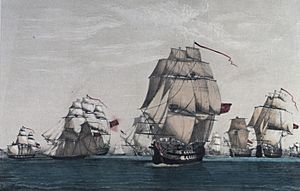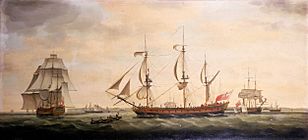Action of 9 August 1780 facts for kids
Quick facts for kids Action of 9 August 1780 |
|||||||
|---|---|---|---|---|---|---|---|
| Part of the American Revolutionary War | |||||||
 The British convoy of 63 merchant ships with all but 8 ships captured by the fleet under Luis de Cordova, Unknown author |
|||||||
|
|||||||
| Belligerents | |||||||
| Commanders and leaders | |||||||
| Strength | |||||||
| 31 ships of the line 6 frigates |
1 ship of the line 2 frigates 63 merchantmen |
||||||
| Casualties and losses | |||||||
| None | 3,144 prisoners 55 merchantmen captured |
||||||
The Action of 9 August 1780 was a big naval battle during the American Revolutionary War. In this battle, a Spanish fleet, led by Admiral Luis de Córdova y Córdova, joined by some French ships, attacked a large group of British merchant ships.
The Spanish and French forces managed to capture almost all the British merchant ships. This was a huge blow to Great Britain's trade and economy.
The British convoy had sailed from Portsmouth on July 27. It was protected by one large warship, HMS Ramillies (with 74 guns), and two smaller warships called frigates. On August 9, they met the Spanish fleet.
The Spanish and French fleet captured 55 out of 63 merchant ships. This was one of the biggest captures of ships ever in naval history. The British lost many valuable things, including:
- 80,000 muskets (guns)
- Equipment for 40,000 soldiers
- 294 cannons
- 3,144 men who were taken prisoner
The money lost was huge, about £1,500,000. This included £1,000,000 in gold and over £500,000 in equipment and ships. This event also messed up a secret plan by Britain to make peace with Spain. People in Great Britain remembered this big loss for many years.
Why it Happened
The British convoy left Portsmouth with 63 merchant ships. These ships were carrying many important things.
- Some were East Indiamen and West Indiamen, which were large ships carrying goods from faraway places.
- Others were supply ships, military store ships, and transports carrying soldiers.
- The soldiers were going to the West Indies. They had tents and camp equipment with them.
- The five East India ships also carried lots of naval supplies for British warships in that area.
On August 2, the convoy met the Channel Fleet, which was a group of British warships. The Channel Fleet sailed with the convoy for a few hours. They then separated, with the convoy continuing its journey alone.
The Battle Begins
The Spanish fleet, led by Luis de Córdova, had left Cádiz. They sailed towards Madeira and the Canary Islands. Admiral Córdova sent out several frigates to look for the British convoy. On the night of August 8, one of these frigates found the convoy.
At first, the Spanish weren't sure if it was the British war fleet or just the merchant convoy. The second-in-command, José de Mazarredo, pushed for an immediate attack. He believed it had to be the convoy because the main British war fleet wouldn't be sailing so far from the English Channel.
When the British ships saw strange sails (the Spanish fleet), Captain Moutray, who was leading the British, told his ships to change direction. The two frigates and eight of the merchant ships followed him and managed to escape.
However, most of the British convoy made a mistake. They thought the lights on the mast of the Spanish flagship, the Santísima Trinidad, were from their own leader. They were tricked by a clever war tactic. So, they sailed right into the Spanish fleet. When morning came, they found themselves surrounded by Spanish ships. Admiral de Córdova then gave the signal for a general chase, meaning all his ships should go after the British.
De Córdova's fleet captured 50 West Indiamen and all five East Indiamen. This made a total of 55 captured ships. It was the worst disaster in the history of the East India Company. The huge 120-gun warship Santísima Trinidad fired on some of the British ships to make them surrender. One ship, Gatton, was even set on fire, but the fire was put out, and the ship was captured.
The captured British ships were taken to Cádiz, a Spanish port. It was amazing to see so many enemy ships captured at once. This was a big failure for British intelligence. The British Admiralty (their navy leaders) didn't even know an enemy fleet was at sea until August 4, just a few days before the attack.
What Happened Next

One British officer, who was a prisoner, wrote about how well the Spanish treated them:
We received fourteen shot from one of the seventy-four's had two men killed and six wounded, our bowspirit shot and shivered up as far as the gammoning, when we struck to the Ferme, a 74. (The Spanish Firme) We were all, except the ladies and their husbands, the captains, first and second officers, and about six other gentlemen, ordered on board the Ferme: but on going on board, had it in our option to return; which we all did; and we met with the greatest civility, humanity, and generosity on board [...] The great kindness of the Spaniards makes our situation scarcely felt, as everything is done by them to alleviate our misfortune; and we have never yet felt that we were prisoners
The Spanish treated their prisoners very kindly. This was a way of returning the good treatment their own countrymen had received from British Admiral Rodney.
This Spanish victory, along with bad storms that damaged British ships in the Caribbean, caused a financial crisis. Many insurance companies across Europe went bankrupt. The cost of war insurance, which was already high, became extremely expensive. This event also made people in Britain very unhappy with their government and how the Royal Navy was being managed.
This successful attack showed that the British fleet, which was spread out in too many places, lost control of the Atlantic shipping routes in 1780.
The five captured British East Indiamen were added to the Spanish navy. They were renamed and used as supply ships or warships. For example:
- The 30-gun Hillsborough became the 12-gun Santa Clotilde.
- The 28-gun Mountstuart became the 34-gun Santa Balvina.
- The 28-gun Royal George became the 40-gun Real Jorge.
- The 28-gun Godfrey became the 34-gun Santa Biviana.
- The 28-gun Gatton became the 34-gun Santa Paula.
Some British merchant ships, like British Queen and Fanny, managed to escape. Their special copper sheathing (a protective layer on the hull) helped them sail faster and get away from the Spanish ships.
See also
 In Spanish: Acción del 9 de agosto de 1780 para niños
In Spanish: Acción del 9 de agosto de 1780 para niños

